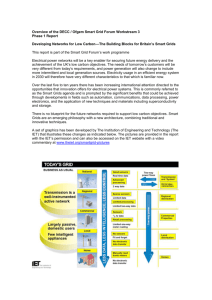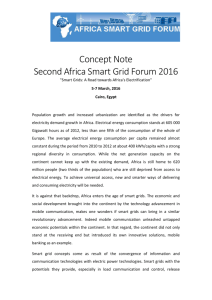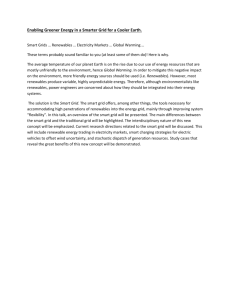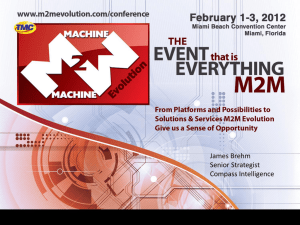BenrachiMaassam_EG3 - Docbox
advertisement
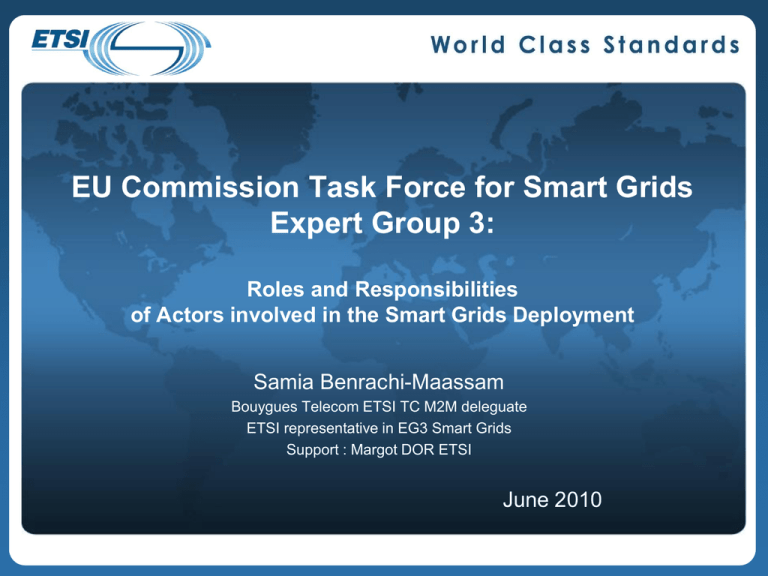
EU Commission Task Force for Smart Grids Expert Group 3: Roles and Responsibilities of Actors involved in the Smart Grids Deployment Samia Benrachi-Maassam Bouygues Telecom ETSI TC M2M deleguate ETSI representative in EG3 Smart Grids Support : Margot DOR ETSI June 2010 Summary EG3 Status Introduction, scope of work Roles & responsibilities – current status Interfaces & Interactions Benefits, criteria & recommendation for funding of Smart Grids Roles & responsabilities – recommendation on scope, policy & regulation directions Needs for new regulation -------------------------------------------------------------------------------------------------- ETSI Vision of Smart Grids 2 EG3 Introduction, Tasks & scope of work Scope of work Expected benefits from Smart Grids for their own organisation Smart Grids features provided by their own organisation Smart Grids features needed from other actors; Defined decision criteria for the deployment of specific Smart Grids features; Roles & responsibilities within their organisation relating to Smart Grids deployment; Anticipated (or already identified from current/previous Smart Grid deployment) interfaces and interaction with other actors in the electric power supply chain required for Smart Grids deployment The key deliverables Development of recommendations on the roles and responsibilities of all involved actors in the implementation of Smart Grids Definition of criteria and recommendations for the funding of Smart Grids deployment 3 Current State Energy Market Place Grid Users, Customers Generators, Suppliers, Retailers, Customers/Consumers: Industrial customer, Transportation customer, Buildings, Home customer Influencers Power Exchange/ Balance Responsible Party Clearing & Settlement agent/ Trader/Supplier/Aggregator Grid User Customer Consumer Regulator Providers of Technologies, Products and Services ETSI Electric Power Grid Equipment vendors, Ancilliary Services providers Metering Point Service Providers Metering Point Service Operators Information & Communication Technology (ICT) service providers Grid communications network providers Home Appliances vendors Building Automation / Energy Management providers Electric Transportation / Vehicle Solutions providers Standard. Bodies EU and national authorities Financial Sector undertakings Network Operators Distribution System Operator (DSO), Transmission System Operator (TSO) Grid communication can be ensured by TSO, DSO or ICTs 4 Interfaces & Interactions 1/2 Electric Supply Chain: Importance of the interaction between TSO and DSO DSO interacting more frequently than today with TSOs, consumers and generator Storage: include electrical battery connected to the grid Interface between DSO and « Storage Owners » Interface & interaction relation to Smart Metering (following 3rd Electricity Directive) More flexible products: higher flexibility and volatility in the electricity supply chain Most of roles & responsabilities are within the DSO Domain 5 Interfaces & Interactions 2/2 Recommendations: 9 recommendations has been endorsed by EG3 1 recommandation added by ETSI to emphasize the role of ICT and Communication Networks… « Interfaces Recommendation #7: EG3 recommends interfaces to be specified between either of these entities and communication service providers:TSO, DSO, Agregators, Grid Users, BRP, Storage Owners. Theses interfaces are typical user to network interfaces and specify the agreed service level agreements which have a legal and technical part (QoS, security level, privacy, etc.)” 6 Benefits, Criteria and Recommendation for Funding of Smart Grids Deployment Proposed process for elaboration of recommendations for funding The EU Smart Grids has defined six priorities for the Smart Grids deployment in the Strategic Deployment EG1 has adopted the key elements of this definition, describing them as the “high-level Smart Grids services” A. Enabling the grid to integrate users with new requirements B.Enhancing efficiency in day-to-day grid operation C. Ensuring grid security, system control and quality of supply D. Better planning of future grid investment E. Improving market functioning and customer service F. Enabling and encouraging stronger and more direct involvement of consumers in their energy usage 6 Recommandations have been endorsed by EG3 7 Roles & responsabilities recommendation on scope, policy & regulation directions Grid Users, Customers Energy Market Place Influencers Generators Suppliers Retailers, Customers/Consumers Industrial customer, Transportation customer, Buildings, Home customer Distributed Energy Balance Resources Power Exchange/ supplying customers that produce Responsible Party some of their electricity as well Clearing & Settlement new load profiles / flexibility agent/ measures should help retail suppliers to Trader/Supplier/Aggregator Grid User Customer optimize their procurement from the energy market. Consumer & Smart Meters Providers of of Technologies, Technologies, Products Products and and Services Services Providers Electric Equipment vendors, No clear Power actors Grid defined with clear scope, however nice statements Ancilliary have been Services made: providers Metering Point Service Providersservice providers will have to offer i.e « In addition, communication Meteringaddressing Point Service services theOperators electricity industry needs. Given the critical Information & Communication Technology (ICT) service providers role of the electricity supply, communication service provides must Grid communications network providers ensure that their services deliver the required quality,security, privacy Home Appliances and reliability. Thisvendors is specially requested under emergency conditions Building Automation / Energyneed Management that may arise. Grid Services to rely onproviders maximum accessibility Electric Transportation / Vehicle Solutions providers and coverage” Network Grid Operators Regulators Standard. Bodies EU and national Legislation authorities Financial Sector undertakings Distribution System Operator (DSO), Transmission System Operator (TSO) Need to futher define roles & actors in Providers of technologies, Products and Services 8 Need new regulation? State of play of the EU Task force (expert Group) activities: findings and roadmap: 1. There is a need for standardization, harmonized approach to all issues (technical, privacy / data protection, organisational, cross-issues between energy and ICT, etc); very important: INTEROPERABILITY 2. There is no need for new Directives or Regulation but instead a need for harmonized and effective implementation of the 3rd Package 3. A range of consumer related issues need to be addressed accordingly, mainly on implementing 3rd Package, including appropriate market instruments and: easier switching of supplier or energy form, consumer protection, standards, dealing with environmental issues and putting benefits of that to the consumers, etc; a particularly important issue is a principle of privacy by design implemented in the European law (e.g. data minimization (use only data you need for application), deadlines for storage of the data, procedures of deleting the data, anonimization) 4. Strengten Support for RIGHT and SMART investment and ensure adquate return 5. Need to LEGALLY enable TSOs and DSOs to fulfill their duties (also mainly implementing 3rd package and sometimes correcting national framework) 9 EU Commission Task Force for Smart Grids ETSI Vision of Smart grids Samia Benrachi-Maassam: Bouygues Telecom ETSI TC M2M deleguate/ EG3 representative Omar Elloumi Alcatel-Lucent TC M2M Vice chair/ EG1 ETSI representative June 2010 Smart grids concept – m2m architecture Service Plane Billing e-Commerce Data models Subscription management and activation Applications Business processes Cross –Plane functions: Connectivity plane function: OAM-style functions (sanity checking of sensors) Traffic engineering, protection and restoration, virtualzation, routing Access technologies Energy control plane function: Substation automation, condition monitoring/diagnosis, supervision and protection Time synchronization Metering E2E QoS & Security Service Control & connectivity Energy Plane: Sensors Electric storage and interconnection Transmission and Distribution Power Systems, etc. 11 Energy IP network Management Functions Aggregation, deaggregation M2M Architecture Involvement level of actors in Smart Grids Actors Energy Plane Control & Connectivity Plane Service Plane Grid operator: DSO Grid operator: TSO Consumers/Suppliers/generators Energy MarketPlace Actors Grid Communication/ Communication Network Provider Service Providers Increasing level of Involvement 12

